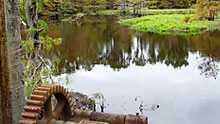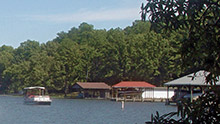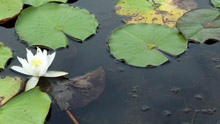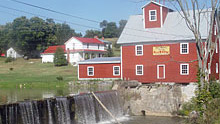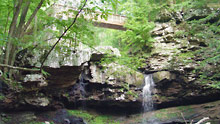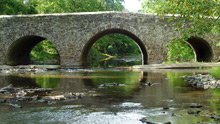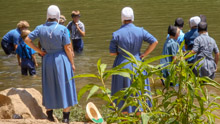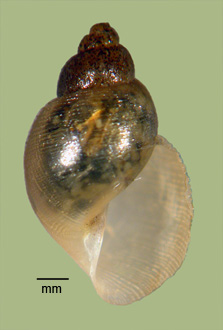> Habitat & Distribution
Lymnaea caperata is typically an inhabitant of more northern latitudes, ranging coast to coast from New York to California, north to through Alberta and south through Colorado (Baker 1928, Clarke 1981, Wu 1989, Jokinen 1992). Populations are most commonly found in wetlands, primarily inhabiting vernal ponds, weedy ditches, and the shallow margins of rivers and lakes (Stewart 2006). Baker (1911) mapped quite a few records in Pennsylvania west through Ohio, Indiana, and Illinois, including one as far south as Virginia (Beetle 1973).
We have but one single modern record in our database from east of the Mississippi River, however, at a boat ramp on the Wabash River. Morningstar an colleagues analyzed a population from "ephemeral pools on the floodplain of the Wabash River near New Harmony" (presumably the type locality) about 20 miles south of that boat ramp in 2017. Lymnaea caperata is pseudo-rare in our 17-state Eastern study area, FWGNA incidence rank I-1p.
Populations of L. caperata become much more abundant in The Great Plains, however, the species ranking #6 in incidence (of 33 species) in Kansas, Nebraska, and The Dakotas.
> Ecology & Life History
The vernal character of the wetlands typically inhabited by L. caperata seems to have discouraged study of their population biology. One might speculate that they share the annual, semelparous life cycle typically displayed by larger-bodied pulmonates in northern latitudes (Dillon 2000: 156-162), overwintering beneath the frozen soil, emerging to reproduce with the spring thaw. Lymnaea caperata was mentioned in the summer diet of Blue-winged teal by Swanson & Meyer (1977).
> Taxonomy & Systematics
Morningstar et al. (2017) published a nice genetic and morphometric survey of four L. caperata populations - two from New Mexico, one from Texas, and one from the type locality in southern Indiana, reporting strikingly high levels of shell morphological variation, both within and among populations, accompanied by surprisingly modest levels of DNA sequence divergence.
Baker (1911) initially assigned caperata to the genus Galba (Schrank), transferring the taxon to Stagnicola (Leach) in 1928. But we follow Hubendick (1951) in preferring the inclusive genus Lymnaea, with Stagnicola a subgenus. See my essay of 28Dec06 (link below) for more.
Hubendick (1951) suggested that the nomen caperata might be a
junior synonym of humilis
(Say 1822), a minor lapse in an otherwise masterful work of scholarship.
> Maps and Supplementary Resources
- Lymnaeid distribution in the drainages of The Ohio (2019)
- Lymnaea distribution in The Great Plains (2024)
> Essays
- See my post to the FWGNA blog of 28Dec06 for a review of The Classification of the Lymnaeidae.
> References
Beetle, D. (1973)
A checklist of the land and freshwater mollusks of Virginia. Sterkiana,
49:21-35.
Baker, F. C. (1911)
The Lymnaeidae of North and Middle America, Recent and
Fossil. Special Publication, vol. 3. Chicago Academy of
Natural Sciences, Chicago.
Baker, F. C. (1928)
Freshwater Mollusca of Wisconsin, Part I, Gastropoda. Bull. Wisc. Geol.
Natur. Hist. Survey, vol. 70. University of Wisconsin Press,
Madison.
Clarke, A.H. 1979. Gastropods as indicators of
trophic lake stages. Nautilus 93:138-142.
Clarke, A.H. 1981.
The Freshwater Molluscs of Canada. National Museum of Natural
Sciences, National Museums of Canada, Ottawa, Canada.
Dillon, R.T., Jr. 2000.
The Ecology of Freshwater Molluscs. Cambridge University
Press, Cambridge, United Kingdom.
Hubendick, B. 1951.
Recent Lymnaeidae. Their variation, morphology, taxonomy, nomenclature,
and distribution. Kungl. Svenska Vetensk. Akad. Handl., 3,
1-223.
Jokinen, E.H.
1992. The Freshwater Snails (Mollusca:
Gastropoda) of New York State. NY State Mus Bull 482, Albany, New
York.
Jokinen, E.H. 2005.
Pond molluscs of Indiana Dunes National Lakeshore: then and now. Amer
Malac Bull 20:1-9.
McKillop, W. B. 1985.
Distribution of aquatic gastropods across the Ordovician dolomite
Precambrian granite contact in southeastern Manitoba, Canada. Can J
Zool 63:278-288.
Morningstar, C.R., Inoue,
K., Lang, B.K. and Berg, D.J. (2018)
A comprehensive status, phylogenetic, and anatomical review of
Stagnicola caperata (Say, 1829) in the south-west United
States.
Aquat Conserv 28 (3), 527-534.
Pip, E. 2000.
The decline of freshwater molluscs in southern Manitoba. Can Field-Nat
114:555-560.
Stewart, T. (2006)
The freshwater gastropods of Iowa (1821-1998): Species composition,
geographic distributions, and conservation concerns. Amer. Malac.
Bull., 21:59 - 75.
Stewart, T.W., and R.T.
Dillon, Jr. 2004. Species composition and geographic
distribution of Virginia s freshwater gastropod fauna: a review using
historical records. Amer Malac Bull 19:79-91.
Swanson, G. &
Meyer, M. (1977) Impact of fluctuating water levels on
feeding ecology of breeding blue-winged teal. J. Wildl. Manage.,
41:426-433.
Wu, S.-K. (1989)
Colorado Freshwater Mollusks. Natural History Inventory of Colorado,
vol. 11. Univ. Colorado Museum, Boulder.

